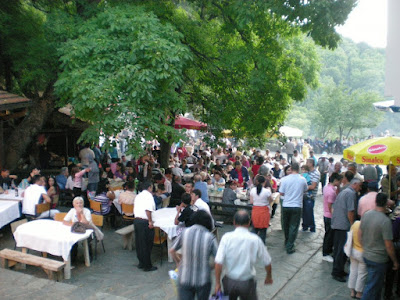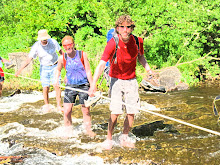Once on this blog I wrote that I hoped to someday have a beer named after me, a nice ale perhaps. Tasty (if not tasteful) immortality. But after touring many of the archaeological sites and museums of Greece, I'm beginning to question this. No, what I really need to withstand the crushing anonymity of time is a marble bust. I can now see that my chiseled face, chiseled in stone, along side Jillian's, will have people two millennia from now wondering exactly who, "Dan Kearney, Human" was.
I know this is possible now because I've been to Greece where we just wrapped up a fantastic two week trip with my parents. Inside the National Archaeological Museum there's a whole colony of marble busts and statues: sages, seers, philosophers, emperors and gods. You expect those, but what I didn't expect to see mixed among the legends were ordinary citizens. There was "Man, 100 B.C.", and "Woman, 61 B.C.", and so on, saved for posterity. Who were they? Who knows, but over 2000 years later there I was, considering their lives.
The sites from which the artifacts were pulled were even more impressive--it was a veritable tour of the ancient world, from the Minoans on Crete and the Mycenaeans on the Peloponnese to the classical Greeks at Athens, Olympia and Delphi.
At Delphi, getting some sage advice from the Oracle
Ancient Mycenae, source of the Homeric tales, was particularly fascinating (despite the 104° heat) because it was one of those moments when something you've learned in school all comes rushing back. It was fun to consider Agamemnon, Helen, Argos, and the war with Troy while standing atop the ruins of the ancient palace. Legends tells us, that the Mycenaeans contracted out much of the construction of the palace to the Cyclops, the ancient world's day laborers, who built the daunting walls and the famous Lion's Gate entrance, both of which still stand. But neither of those prepare the visitor for entering the Treasury of Atreus, an immense beehive-shaped burial chamber. On second thought, maybe a marble bust isn't the way to go...

Dan atop the bee-hive tomb thought to be Agamemnon's
In both climate and terrain, Greece is much like Southern California, so it makes sense that it gets mentioned in Joni Mitchell's 1970 ode to the Golden State. She sings about having her camera stolen by a lovable "redneck" islander, and while I can't confirm the presence of thieves, I can wholeheartedly agree that Grecian islands are where it's at. In addition to Crete, full of beautiful beaches and Venetian villas, we visited Santorini, where we slept in a cave. Seriously.
Some millennia ago one of the most powerful volcanic eruptions ever to occur on Earth turned a small Mediterranean island into three or four smaller islands and the largest, Santorini, shows plenty of the evidence of that trauma. For one, volcanic rock is scattered everywhere and much of the local art is based on shaping and sculpting it. The blast also left much of the island's jagged cliffs dotted with caves made from the porous volcanic rock. These caves are basically the pre-historic version of a climate controlled apartment. Warm in the winter and cool in the summer, these caves were historically where the island's poor lived, until someone got the bright idea that visitors might pay to stay in them. The rest is tourism history and now these caves and the cliff side they occupy, painted white, are some of the most photographed sites in all of Greece.
A look from our cave villa in Santorini
It was on Santorini that my parents got their first--but not their last--taste of Balkan hospitality. Following a meal out, the waiter invited us in for a round of rakia (a regional liquor that could probably have powered early trains), called "raki" or "tsikoudia" in Greece. Much to my surprise, my father seemed to like it and went on to drink it on a number of occasions. And forget sipping the stuff, as is custom, he just sent it straight down the hatch. Shame he couldn't make it to Macedonia, he'd be a bit hit.
During the epic final scene of "For Your Eyes Only", James Bond scales an impossibly high vertical rock face to reach a beautiful old, asymmetrical building where he inevitably saves the girl and foils the villain. Once you get past Roger Moore, who somehow manages to seem wooden while rock climbing, you'll invariably ask, "Where did they film this?" Though in the movie the building is some elaborate hunting lodge, it's actually a monastery in an area of Greece called Meteora. In response to the impending Turkish invasion some 600 years ago, Greek Orthodox monks retreated to the rocky landscape and built 24 sanctuaries in some of the most unlikely places. Today, 6 remain.

The Holy Monastery of Varlaam, built in 1541
Those first pioneering monks should be happy to know the Ottomans never found then, but the tour buses sure did. Winding along roads presumably designed with pack mules in mind, the buses deliver the visitors by the thousands on a daily basis and make driving for us mere mortals in cars slightly harrowing.
But past those buses and crowds are the views, which are something a bit like the Grand Canyon: everywhere you look, it's a post card waiting to happen. The "what" is impressive enough--elegantly minimalist monasteries with fascinating frescoes--but it's the "how" that really blows the mind. How did the monks do it? What compelled them, after arriving at the base of a towering and jagged rock formation, to say, "Yeah. Let's build up there. Get that prime real estate while it's still available." Maybe they hired some Cyclops.
As always, more pictures can be seen by clicking on "Our Photos" on the right sidebar.










